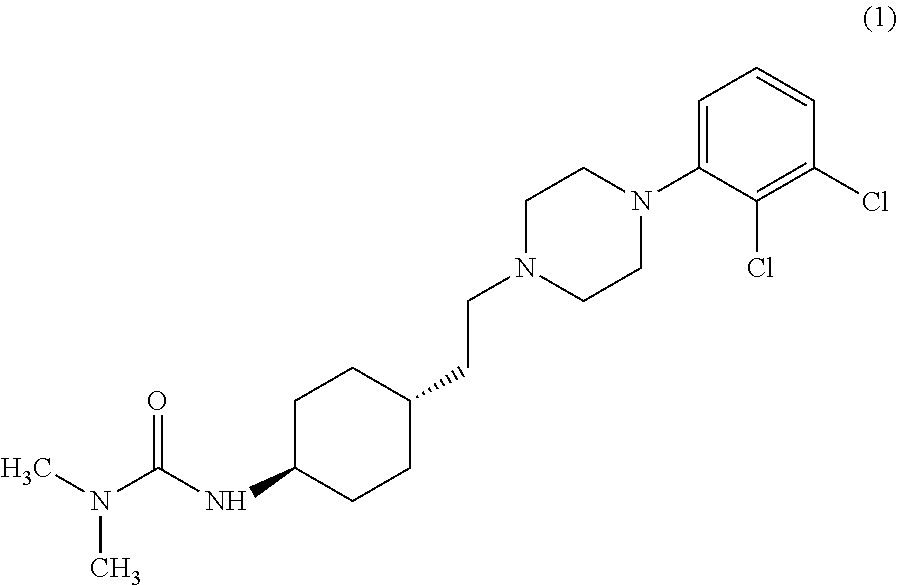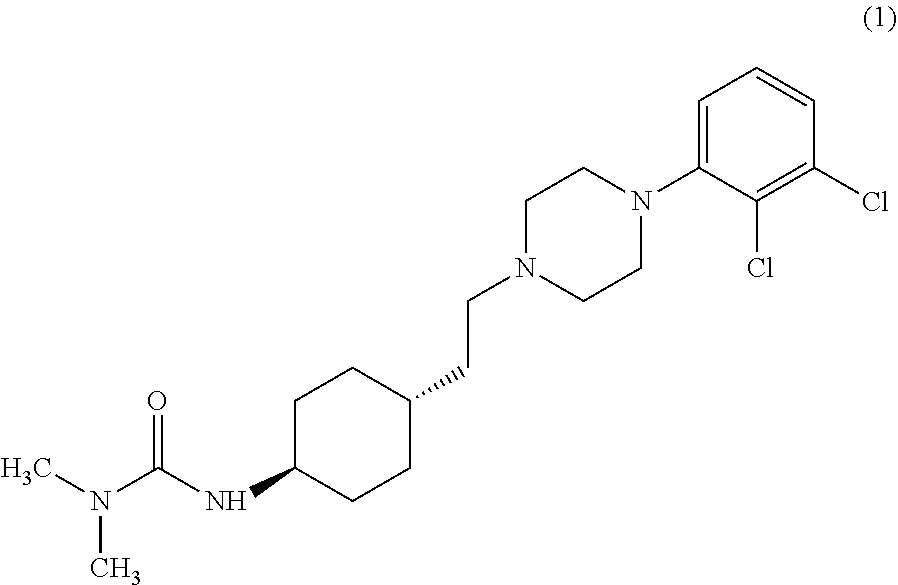Industrial process for the preparation of cariprazine
- Summary
- Abstract
- Description
- Claims
- Application Information
AI Technical Summary
Benefits of technology
Problems solved by technology
Method used
Image
Examples
example 1
Trans-4-aminocyclohexyl acetic acid
[0037]2.21 g of trans-4-aminocyclohexyl acetic acid ethyl ester hydrochloride, 10 ml of methanol and 5 ml of 6N sodium hydroxide solution were charged into a flask. After 2 hours, from the mixture methanol was evaporated in vacuum and then 3 ml solution of 6N hydrochloric acid was dropped to the residue at 0-5° C. temperature. After stirring the suspension for 30 minutes, the product was filtered off and dried under vacuum at 45° C. temperature to constant weight. Thus 0.50 g of product in a white powder form was obtained (yield: 32%; DSC: 259.59-292.07° C.).
[0038]1H NMR (D2O, 800 MHz): 3.13 (tt, J=12.0, 4.0 Hz, 1H), 2.08 (d, J=7.4 Hz, 2H), 2.03 (br d, J=12.1 Hz, 2H), 1.81 (br d, J=12.9 Hz, 2H), 1.61-1.68 (m, 1H), 1.41 (qua d, J=12.5, 3.3 Hz, 2H), 1.09 (qua d, J=12.6, 3.0 Hz, 2H) ppm. 13C NMR (D20, 201 MHz): 185.5, 53.0, 47.5, 36.9, 33.1, 32.8 ppm. MS: ESI pos.: [M+H]+=158; ESI MS / MS, CID=35%, m / z (rel. int. %): 141(100), 123 (6).
example 2
Trans-4-aminocyclohexyl-acetic acid hydrochloride
[0039]22.2 g of trans-4-aminocyclohexyl-acetic acid ethyl ester hydrochloride and 45 ml of 6N hydrochloric acid solution were charged into a flask. The reaction mixture was refluxed for 16 hours, cooled to 20-25° C. temperature and after 30 minutes stirring the product was filtered off from the resulting suspension, which was dried under vacuum at 45° C. temperature until constant weight. Thus 12.61 g of product is obtained in a white powder form (yield: 65%; DSC: 207.45-211.59° C.).
example 3
Trans-4-{[(dimethylamino carbonyl]amino}cyclohexyl) acetic acid
[0040]33 ml of water and 1.90 g of trans-4-aminocyclohexyl-acetic acid hydrochloride were charged into a flask, then 3.36 g of sodium bicarbonate was added to the solution. The resulting solution was cooled to 0-5° C. temperature and 1.40 ml dimethyl-carbamoyl chloride was added to that dropwise. The reaction mixture was stirred for 30 minutes at this temperature and then for 2 hours at 20-25° C. The reaction mixture was cooled again to 0-5° C. and 7.5 ml of 6 N hydrochloric acid was added dropwise. After stirring for 30 minutes, the product was filtered off from the suspension and dried under vacuum at 45° C. temperatures to constant weight. Thus 2.03 g of a product was obtained in a white powder form (yield: 89%; DSC: 206.73-217.37° C.).
[0041]1H NMR (DMSO-d6, 500 MHz): 12.00 (br s, 1H), 5.86 (d, J=7.9 Hz, 1H), 3.32 (tt, J=11.7, 3.8 Hz, 1H), 2.75 (s, 6H), 2.09 (d, J=7.0 Hz, 2H), 1.65-1.78 (m, 4H), 1.50-1.61 (m, 1H), 1.2...
PUM
 Login to View More
Login to View More Abstract
Description
Claims
Application Information
 Login to View More
Login to View More - R&D
- Intellectual Property
- Life Sciences
- Materials
- Tech Scout
- Unparalleled Data Quality
- Higher Quality Content
- 60% Fewer Hallucinations
Browse by: Latest US Patents, China's latest patents, Technical Efficacy Thesaurus, Application Domain, Technology Topic, Popular Technical Reports.
© 2025 PatSnap. All rights reserved.Legal|Privacy policy|Modern Slavery Act Transparency Statement|Sitemap|About US| Contact US: help@patsnap.com



